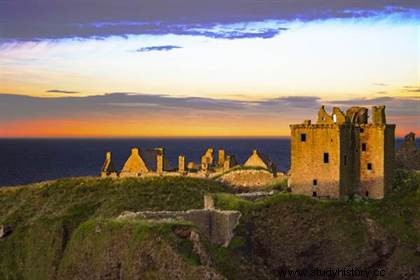 Scottish History , it is above all that of a country marked by an almost continuous rivalry with England. It is that of a people who brandish as heroes William Wallace and Robert Bruce, the famous "Braveheart", who fought against English oppression in bloody battles. It is also that of Marie Stuart, queen of France and Scotland with a tragic destiny; that of the Enlightenment theoreticians and great inventors of the 18th and 19th centuries. From the wild lands of the Highlands to industrial Glasgow, from the distinguished city of Edinburgh to the wild islands of the north, Scotland offers us a fascinating plural history.
Scottish History , it is above all that of a country marked by an almost continuous rivalry with England. It is that of a people who brandish as heroes William Wallace and Robert Bruce, the famous "Braveheart", who fought against English oppression in bloody battles. It is also that of Marie Stuart, queen of France and Scotland with a tragic destiny; that of the Enlightenment theoreticians and great inventors of the 18th and 19th centuries. From the wild lands of the Highlands to industrial Glasgow, from the distinguished city of Edinburgh to the wild islands of the north, Scotland offers us a fascinating plural history.
Scotland, from one settlement to another
The history of Scotland really begins in the 1st century BC. AD, when Celtic tribes from the Rhineland and Ireland settled in the territory. They will oppose fierce resistance to the Romans. The latter, after having annexed Britannia (England), continued their conquest further north and arrived in Scottish lands in 78 AD. The Roman legions will remain there for a century, without however reaching the Highlands region or managing to subjugate the inhabitants, whom they call Picts (“painted men”). The latter thus acquired the reputation of a warrior people. Moreover, in order to protect Britannia from Celtic incursions, 2 walls are erected:
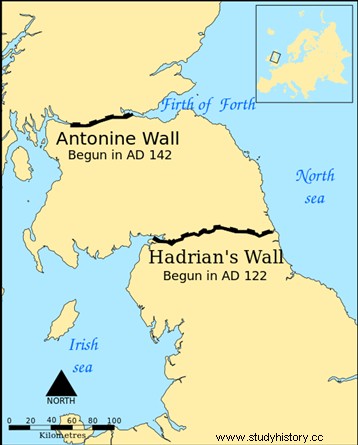 - Hadrian's Wall, nearly 120 km long between the west and east coasts, which marks the border between Britannia and Caledonia;
- Hadrian's Wall, nearly 120 km long between the west and east coasts, which marks the border between Britannia and Caledonia;
- the Antonine Wall, further north than Hadrian's Wall, built between the River Forth to the east and the River Clyde to the west.
After the departure of the Romans in the 4th century, the Picts united and dominated the north-east of Scotland. Other settlements follow. The Scots, Christian Celts from Ireland, arrive from the west with their culture and their language, Gaelic, which will gradually spread into the kingdom of Alba (Gaelic name for Scotland). The Brittons settled in the southwest and the Angles in the southeast. At the same time, Christian missionaries evangelized the populations and all of Scotland was Christianized from the end of the 7th century.
But a threat lurks:the Vikings increase their raids from 794, until they take control of the islands (Shetland, Orkney, Hebrides) and the north coast. To resist their advance, Picts and Scots unite. This is the beginning of a slow unification of the country. In the 11th century, the kingdom took the name of Scotland, the “country of the Scots”. However, in the northern part of the territory, the Scandinavians did not withdraw until the 13th century. The occupation will end completely in 1469 with the integration into Scotland of Shetland and Orkney.
Complex links forged with England
Several kings succeed each other at the head of the new kingdom. Among them, the famous Macbeth, who kills Duncan I to accede to the throne in 1040 and is assassinated, after 17 years of reign, by Duncan's son. The latter reigned under the name of Malcolm III from 1058 to 1093. This period marked the beginning of a complex relationship with England. On the one hand, the king multiplies the incursions into England in order to extend the territory of Scotland, an enterprise which will fail despite five attempts. On the other hand, he governed under the influence of his wife Margaret, an exiled Anglo-Saxon:the court adopted the English language and the Church was reformed to be fully integrated into the Catholic Church. The Queen also welcomed many nobles fleeing England due to the Norman Conquest.
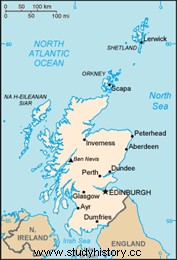 Their son David, owner of vast estates in England and well known at court, introduced the feudal system to Scotland English style during his reign, from 1124 to 1153. English, but also French and Normans, were offered lands and powers, in exchange for which they had to swear their loyalty to the Scottish crown. However, the conflict with England remains endemic. It will reach its climax in 1174, when King William I was captured and was forced to accept the English takeover of his kingdom. This will last fifteen years. The two countries then experience a period of peace, which will last almost a century. In 1237, the Treaty of York established the current Anglo-Scottish border while in 1251, the two countries were linked by the marriage of the King of Scotland Alexander III with the sister of the King of England.
Their son David, owner of vast estates in England and well known at court, introduced the feudal system to Scotland English style during his reign, from 1124 to 1153. English, but also French and Normans, were offered lands and powers, in exchange for which they had to swear their loyalty to the Scottish crown. However, the conflict with England remains endemic. It will reach its climax in 1174, when King William I was captured and was forced to accept the English takeover of his kingdom. This will last fifteen years. The two countries then experience a period of peace, which will last almost a century. In 1237, the Treaty of York established the current Anglo-Scottish border while in 1251, the two countries were linked by the marriage of the King of Scotland Alexander III with the sister of the King of England.
The Wars of Independence and the Auld Alliance
It is a dynastic crisis that will put an end to the golden age of medieval Scotland. When Alexander died in 1286, the crown passed to his granddaughter Margaret. She died prematurely four years later, leaving no heir. The pretenders to the throne are not lacking... The situation quickly becomes inextricable, so much so that the choice of the new Scottish sovereign is left in the hands of King Edward I of England. He appoints John Balliol and forces the latter to accept the suzerainty of England. Very quickly, Balliol rebels and seeks the support of France, with whom he hopes to form a common front against England. This is the birth of the Auld Alliance ("Old Alliance"), which will govern the "foreign policy" of Scotland for 250 years. The consequences are not long in coming:the King of England chases Balliol from the throne and, from 1296, the English become militarily and politically masters of Scotland.
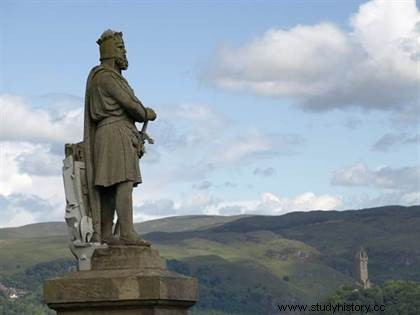 Arising from the west of the country, an obscure knight raised today to the rank of legend, William Wallace, takes the lead in the fight against the occupiers. He won the battle of Stirling in 1297 then suffered a defeat which forced him to hide for seven years. Betrayed, he was captured and then executed by the English in London. Enter the no less famous Robert Bruce, "Braveheart", a descendant of a wealthy Norman family. He proclaims himself king and takes advantage of the accidental death of Edward I to push the English out of the Scottish borders. The victory of Bannockburn, in 1314, the most famous in the history of the country, put an end - temporarily - to the great offensives against the English.
Arising from the west of the country, an obscure knight raised today to the rank of legend, William Wallace, takes the lead in the fight against the occupiers. He won the battle of Stirling in 1297 then suffered a defeat which forced him to hide for seven years. Betrayed, he was captured and then executed by the English in London. Enter the no less famous Robert Bruce, "Braveheart", a descendant of a wealthy Norman family. He proclaims himself king and takes advantage of the accidental death of Edward I to push the English out of the Scottish borders. The victory of Bannockburn, in 1314, the most famous in the history of the country, put an end - temporarily - to the great offensives against the English.
The conflict, however, remained endemic until 1357 and the signing of the Treaty of Berwick, which officially ended the wars of independence. At the same time, the Scottish nobles sent the Pope the "Declaration of Arbroath", by which they asked him to recognize the independence of Scotland and its king Robert Bruce. The response of the sovereign pontiff - favorable - reached them in 1328. April 6, the day of the signing of the declaration, became Tartan Day (“Day of Tartan”), celebrated every year throughout the world. It celebrates the spirit of independence of Scots, wherever they are.
The Stuart dynasty:the impossible peace with England
In 1371, the crown passed from the Bruce family to the Stuart family. It is the beginning of a new dynasty, which will reign for 300 years. Edinburgh, a prosperous commercial city on the east coast, became the administrative and political capital under James II. Among the members of the royal family, let us also mention Jacques IV, sovereign from 1488 to 1513. Prince of the Renaissance, he financed the arts, education and took a close interest in scientific research. An emblematic figure of Scottish culture, he is also known to be one of the first personalities to drink whisky. James IV introduces golf and promotes the practice of football.
Politically, Scotland and England once again find themselves in an untenable situation. Tails:James IV married Margaret Tudor, the sister of the future Henry VIII of England, in 1503. This marriage "of the rose and the thistle" brought the two kingdoms closer while opening rights to the English crown to the dynasty Stuart. Side face:Scotland is still linked to France by virtue of the Old Alliance. Consequence:Jacques IV took up arms against his brother-in-law in 1513. An initiative that ended in bloodshed and a serious defeat on the Scottish side at Flodden:the sovereign and most of the Scottish nobles were killed.
Does the Battle of Flodden spell the end of the Auld Alliance? Absolutely not ! This will even be strengthened:the Stuarts will unite with the most powerful family in France, the Guise, with the marriage of Jacques V and Marie de Guise in 1538. The latter will give birth to Marie, who will be very early promised to François, heir to the throne of France. This union should be the culmination of the Old Covenant, but history will decide otherwise...
The Tragic Fate of Mary Stuart
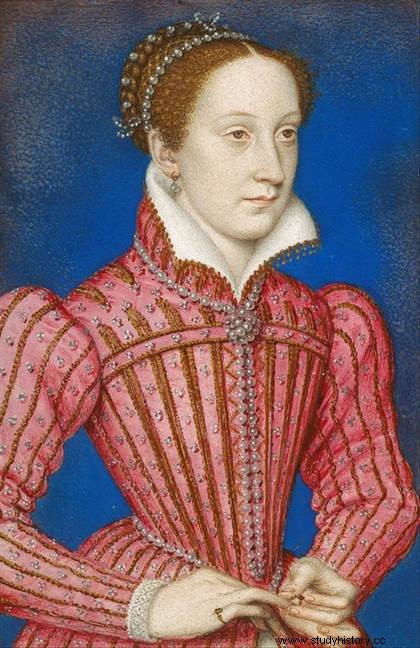 Twice queen, Marie Stuart knows a destiny where passion, betrayal and scandal mingle. Disillusions follow one another and blood flows... It is not surprising that this extraordinary character from Scottish history is now the subject of successful films! Marie becomes Queen of Scotland a week after her birth, when her father is killed during (yet another) battle against the English. His mother, the Catholic Marie de Guise, ensures the regency. At the age of 6, Marie was sent to France, the country where she grew up and married, as planned, the future François II. Events will then speed up. Two years after his coronation, Francis died. In 1561, Marie was 19 and was forced to return to Scotland, which in reality she did not know and where she was not welcome. Some of the nobles rose up against the French presence.
Twice queen, Marie Stuart knows a destiny where passion, betrayal and scandal mingle. Disillusions follow one another and blood flows... It is not surprising that this extraordinary character from Scottish history is now the subject of successful films! Marie becomes Queen of Scotland a week after her birth, when her father is killed during (yet another) battle against the English. His mother, the Catholic Marie de Guise, ensures the regency. At the age of 6, Marie was sent to France, the country where she grew up and married, as planned, the future François II. Events will then speed up. Two years after his coronation, Francis died. In 1561, Marie was 19 and was forced to return to Scotland, which in reality she did not know and where she was not welcome. Some of the nobles rose up against the French presence.
Raised in the Catholic religion, she also discovered a country that swung to Protestantism in favor of the Reformation. The Catholic religion is even abolished. Scotland sees the establishment of a Reformed Church, called Presbyterian, which Mary Stuart is obliged to recognize. She also enjoys an awkward position in the eyes of Elizabeth I, Queen of England. Elizabeth is the last representative of the Tudor line, which leaves the field open to the Stuarts to accede to the throne. In other words:Mary is the heir to the English crown.
After the death of Francis II, the Queen of Scotland would marry two more times, each union turning into a disaster. She is even said to be involved in the murder of her second husband, a murder fomented by her last husband, the adventurer Jacques Hepburn. She had to abdicate in 1567. At 25, Marie Stuart, former Queen of France and Scotland, found herself imprisoned in Loch Leven Castle. She will manage to escape. Cornered, she flees her country and takes refuge with her cousin Elisabeth I. Marie will live in semi-captivity until her death in 1587. Elisabeth, accusing her rival of plotting against England, will have her beheaded.
The Union of the Crowns of Scotland and England
With the death of Mary Stuart a new chapter begins, marked by the union of the crowns of Scotland and England. His son Jacques inherited the two thrones and gave himself the title of James I of Great Britain and Ireland. The sovereign settled in London and, as was the case for his successor Charles I, took little interest in Scotland. However, hostilities resumed in 1639, due to deep religious divisions. While the Scottish Presbyterian Church and the Church of England are both Protestant, conflicting rules govern them. The first refuses both the royal authority and that of the bishops.
The episcopate, on the contrary, structures the organization of the Anglican Church, in which the king holds supreme authority. The confrontation is inevitable. In 1638, faced with the inclinations of Charles I to impose himself at the head of the Scottish Reformed Church and to reintroduce the bishops, the Presbyterians united. They write in an Edinburgh church a document reaffirming their principles:the National Covenant, which they will be 300,000 to sign. The Covenanters raise an army and enter England. Charles I retreats.
Oliver Cromwell's Short-lived Republic
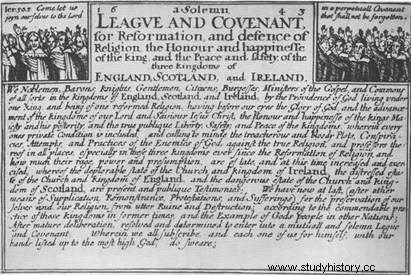 Great Britain descends into a civil war, where each side declares for or against the king. The Covenanters allied themselves with the English parliamentarians. An alliance sealed by the “Solemn and Covenant League”, a document promising the establishment of the Presbyterian Church in England in exchange for Scottish military support to overthrow the king. At first, the enterprise seemed to succeed:in 1646, the king was beaten and handed over to his opponents in England. Charles I was executed in 1649.
Great Britain descends into a civil war, where each side declares for or against the king. The Covenanters allied themselves with the English parliamentarians. An alliance sealed by the “Solemn and Covenant League”, a document promising the establishment of the Presbyterian Church in England in exchange for Scottish military support to overthrow the king. At first, the enterprise seemed to succeed:in 1646, the king was beaten and handed over to his opponents in England. Charles I was executed in 1649.
Under the aegis of Oliver Cromwell, the monarchy is abolished, giving way to a Commonwealth, a form of government close to the Republic. The Scots then realize that England will never adopt Presbyterianism and side with Charles, the son of the executed king. They offer him the throne in exchange for which he must agree to support the Covenanters. Cromwell reacts by sending his troops to Scotland. They won a decisive victory at Dunbar in 1650. After 11 years of conflict, Scotland fully integrated the Commonwealth and no longer had a Parliament.
The Stuart Restoration and the Glorious Revolution
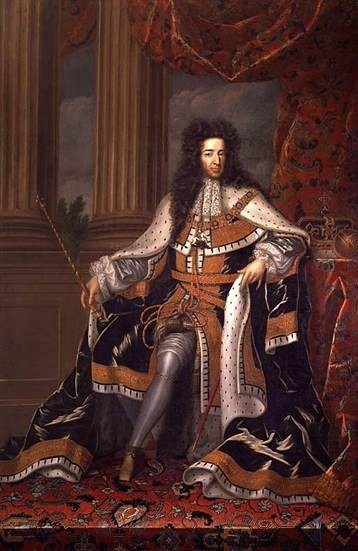 When Cromwell died in 1658, events accelerated. It is already the end of the Commonwealth; Scotland and England once again become separate kingdoms with one and the same king at their head. This king is Charles II, who will quickly reconsider the promise made to the Covenanters. Not only does the sovereign restore the episcopate but he will also organize the repression of the Presbyterians. The persecution will be even more brutal under James VII of Scotland (James II of England), his successor and last Catholic king Stuart. In 1688, William of Orange came to the rescue of the Protestant lords and led the Glorious Revolution. He deposed Charles II, his uncle, then ascended the throne after signing a Bill of Rights, the founding document of the English constitutional monarchy.
When Cromwell died in 1658, events accelerated. It is already the end of the Commonwealth; Scotland and England once again become separate kingdoms with one and the same king at their head. This king is Charles II, who will quickly reconsider the promise made to the Covenanters. Not only does the sovereign restore the episcopate but he will also organize the repression of the Presbyterians. The persecution will be even more brutal under James VII of Scotland (James II of England), his successor and last Catholic king Stuart. In 1688, William of Orange came to the rescue of the Protestant lords and led the Glorious Revolution. He deposed Charles II, his uncle, then ascended the throne after signing a Bill of Rights, the founding document of the English constitutional monarchy.
The Glencoe Massacre
The Church of Scotland is then recognized as independent. The repression then changes sides:this time it is the Jacobites who are the victims (that is to say the faithful of King James). In this context comes a dramatic event that has left an indelible mark on the history of the Highlands:the massacre of Glencoe. Highlands to the north and Lowlands to the south are opposites in every way. Major cities, politics and commerce are concentrated in the lowlands, with Glasgow and especially Edinburgh as anchor points. In the rural highlands, where the majority speak Gaelic, power is held by powerful families, organized into clans. In 1692, the rivalry between the MacDonalds and the Campbells, the two dominant clans, reached its climax against a background of division against the Jacobite movement. Campbell troops, acting on government orders, kill 38 members of the MacDonald family in their home after accepting their hospitality.
The Act of Union or the end of Scottish independence
Queen Anne - who succeeds William of Orange - has no children. The English then take advantage of the weakness of Scotland, almost ruined after having tried in vain to found a colony in the isthmus of Panama, and submit an offer to them:the English Parliament chooses the new king, in this case a new queen. (Sophie of Hanover), in exchange for which commercial advantages will be granted to the Scots. This agreement is subject to one condition:Scotland must renounce its independence. The negotiations for the union of the English and Scottish Parliaments last 5 years. They ended in 1707. On May 1, the Scots woke up as British citizens. By the Act of Union, all powers are transferred to the Parliament of London. The Scottish Parliamentarians therefore left Edinburgh to reach the English capital. However, Scotland remains master of its own destiny in certain areas such as religion, justice and education.
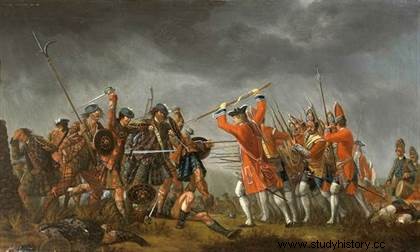 The political consequences are not long in being felt. The Act of Union triggers the Jacobite uprisings:offensives are launched with the aim of a return of the Catholic Stuarts. Among the latter, the figure of Charles-Edouard Stuart dominates. Brave and reckless, "Bonnie Prince Charlie" ("Kind Prince Charlie") manages to raise an army and achieve several victories. His ambitions, however, came to a tragic end in 1746 at Culloden, near Inverness, where his men died under the onslaught of British troops, among whom many Scots fought. In the Highlands, where many families supported the Jacobite cause, the economic and social structure is collapsing. The government takes a radical decision:it dismantles the clans. In addition, wearing a kilt is prohibited, as is the use of Gaelic.
The political consequences are not long in being felt. The Act of Union triggers the Jacobite uprisings:offensives are launched with the aim of a return of the Catholic Stuarts. Among the latter, the figure of Charles-Edouard Stuart dominates. Brave and reckless, "Bonnie Prince Charlie" ("Kind Prince Charlie") manages to raise an army and achieve several victories. His ambitions, however, came to a tragic end in 1746 at Culloden, near Inverness, where his men died under the onslaught of British troops, among whom many Scots fought. In the Highlands, where many families supported the Jacobite cause, the economic and social structure is collapsing. The government takes a radical decision:it dismantles the clans. In addition, wearing a kilt is prohibited, as is the use of Gaelic.
The economic boom of the Lowlands and the Scottish Enlightenment
The doom of the Highlands echoes the booming economic boom of the Lowlands, particularly that of the Glasgow region. The Act of Union is a godsend on the commercial level:the central power opens the doors of the British Empire to Scottish traders. Ideally located on the west coast, Glasgow made a fortune in a few decades thanks to the tobacco, cotton and sugar trade. More broadly, many Scots, attracted by these new horizons, left to make their fortune or became explorers and missionaries. Among the latter is David Livingstone, who traveled through southern Africa for more than 30 years.
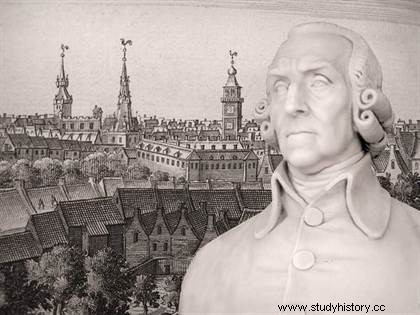 The development of big business took place in a period of intellectual upheaval. From the 1730s/1740s and for a century, Scotland made a brilliant contribution to the Enlightenment movement. Its anchor points? The four universities - St. Andrews, Glasgow, Edinburgh and Aberdeen - which are among the oldest and most renowned in the western world. A new approach to thinking, based on reason and critical reflection, renews theories in many fields while leading to many technical innovations.
The development of big business took place in a period of intellectual upheaval. From the 1730s/1740s and for a century, Scotland made a brilliant contribution to the Enlightenment movement. Its anchor points? The four universities - St. Andrews, Glasgow, Edinburgh and Aberdeen - which are among the oldest and most renowned in the western world. A new approach to thinking, based on reason and critical reflection, renews theories in many fields while leading to many technical innovations.
The philosopher David Hume, in his Treatise on Human Nature, rejects belief and advocates rigorous intellectual debate on all aspects of life. Scientifically, James Hutton is recognized as the father of geology and Joseph Black discovers carbon dioxide. Economist Adam Smith, marked by the economic expansion of Glasgow, theorizes liberalism in Investigations into the nature and causes of the wealth of nations.
Modern times:Scotland, land of innovation
Scotland is a land of innovation, the result of excellent teaching and the creative flair of its engineers and scientists. These will largely contribute to the birth and development of the Industrial Revolution. Here are a few emblematic inventions and discoveries:
- James Watt perfected the steam engine at the University of Glasgow in 1769;
- John McAdam invented the surfacing that bears his name in the 1820s;
- James Nasmyth invents the power hammer, the first machine tool, in 1839;
- Graham Bell develops the telephone in 1876;
- John Boyd Dunlop invents the tire in 1888;
- John Logie Baird created the first Television in 1926.
One of the great names of the era was James Clerk Maxwell. The Edinburgh physicist has notably worked on electric and magnetic fields. Little known to the general public, Maxwell nevertheless bequeathed to science a legacy deemed as decisive as that of Albert Einstein or Isaac Newton. It was also he who, in 1861, was the author of the first true color photo. The subject ? A tartan ribbon!
Industrial Glasgow
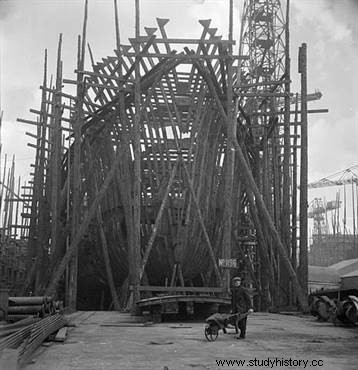 While Edinburgh, the nation's capital, is emerging as a leading intellectual and cultural center, Glasgow turns into an industrial city. The region became one of the engines of the Industrial Revolution thanks to the mechanization of spinning mills, which the steam engine, developed at the University of Glasgow, was to equip from the 1770s. The river, the Clyde , in order to accommodate more boats. Economic growth is exploding, as is the number of inhabitants. Between 1800 and 1850, the population tripled; in 1880, Glasgow was the 6th most populous city in the world, with 587,000 inhabitants. In the 19th century, it acquired the status of "second city of the Empire".
While Edinburgh, the nation's capital, is emerging as a leading intellectual and cultural center, Glasgow turns into an industrial city. The region became one of the engines of the Industrial Revolution thanks to the mechanization of spinning mills, which the steam engine, developed at the University of Glasgow, was to equip from the 1770s. The river, the Clyde , in order to accommodate more boats. Economic growth is exploding, as is the number of inhabitants. Between 1800 and 1850, the population tripled; in 1880, Glasgow was the 6th most populous city in the world, with 587,000 inhabitants. In the 19th century, it acquired the status of "second city of the Empire".
Heavy industry took over from textiles:until the 1920s, shipbuilding was one of the main pillars of the Glaswegian economy. From its shipyards come the most famous ocean liners in the world, such as the Cutty Sark, the Queen Elizabeth and the Queen Elizabeth II. If the economy is flourishing, many neighborhoods are sinking into social misery. The city cannot contain the influx of labour. The newcomers crowd into slums and experience appalling living conditions. In 1911, the number of inhabitants exceeded one million. Among them were Irish people fleeing famine and Highland peasants driven from their land.
The Highland Clearances
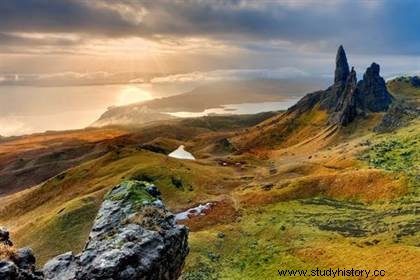 From the end of the 18th century until the middle of the following century, the Highland Clearances were raging. ). The populations, impoverished and no longer benefiting from the protection of the clans, are condemned to leave their territory when traditional agriculture disappears in favor of the extensive breeding of woolen sheep. Little by little, the highlands are emptying. At the same time, the region is adorned with a romantic aura:people come to fish and hunt in the heart of its landscapes, as splendid as they are desolate. Celtic culture is rising from its ashes. Writer Walter Scott plays a notable role in this. During the reception of King George IV in Edinburgh in 1822, he forced the latter to wear a kilt. In 1852, Prince Albert acquired Balmoral Castle near Aberdeen, which would become the royal couple's summer residence.
From the end of the 18th century until the middle of the following century, the Highland Clearances were raging. ). The populations, impoverished and no longer benefiting from the protection of the clans, are condemned to leave their territory when traditional agriculture disappears in favor of the extensive breeding of woolen sheep. Little by little, the highlands are emptying. At the same time, the region is adorned with a romantic aura:people come to fish and hunt in the heart of its landscapes, as splendid as they are desolate. Celtic culture is rising from its ashes. Writer Walter Scott plays a notable role in this. During the reception of King George IV in Edinburgh in 1822, he forced the latter to wear a kilt. In 1852, Prince Albert acquired Balmoral Castle near Aberdeen, which would become the royal couple's summer residence.
In the 19th century, Scotland therefore experienced a profound transformation with the doubling of its population, the industrialization and urbanization of the Lowlands and the virtual desertification of the Highlands .
The resurgence of the desire for independence
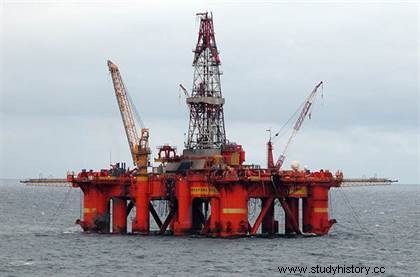 The First World War marked a new break in the country's history. 220,000 Scots lost their lives or were injured there:no other conflict has and will ever have so many victims. Economically, the war effort allowed industry to further increase its production. A golden age that will end as soon as hostilities cease, giving way to the slow agony of a sector on which the economic health of the Lowlands, in particular Glasgow, remains particularly dependent. The looming difficulties are giving rise to social movements and a more politicized working class. In 1919, the government sent the army to George Square in central Glasgow to disperse a communist demonstration. The "Red Clyde" remained at the forefront of political protest until the 1970s. It was then the SNP (Scottish National Party) that gained ground, thanks to the serious economic and social crisis caused by deindustrialisation. .
The First World War marked a new break in the country's history. 220,000 Scots lost their lives or were injured there:no other conflict has and will ever have so many victims. Economically, the war effort allowed industry to further increase its production. A golden age that will end as soon as hostilities cease, giving way to the slow agony of a sector on which the economic health of the Lowlands, in particular Glasgow, remains particularly dependent. The looming difficulties are giving rise to social movements and a more politicized working class. In 1919, the government sent the army to George Square in central Glasgow to disperse a communist demonstration. The "Red Clyde" remained at the forefront of political protest until the 1970s. It was then the SNP (Scottish National Party) that gained ground, thanks to the serious economic and social crisis caused by deindustrialisation. .
The crisis spared a region, however… In 1969, oil and gas were discovered in the North Sea. The production of black gold, from 1975, particularly benefited the city of Aberdeen and its region, which enjoyed new prosperity. In ten years, Great Britain finds itself propelled to 5th place in the world of oil-producing countries. Even today, the latter occupies a significant place in the British economy. This discovery will also contribute to resurrect the idea of an independent Scotland.
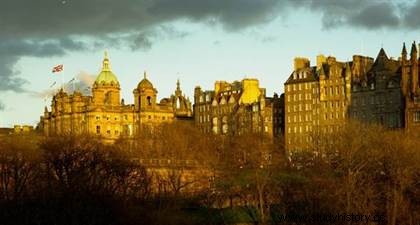 The Scottish Parliament was re-established in 1999 and moved to Edinburgh. The SNP continues to progress until obtaining an absolute majority in the parliamentary elections of 2011. 3 years later, a referendum on independence is organized. 85% of voters show up at the polls. The "no" side won with 55% of the vote. However, the question of independence remains more relevant than ever. In question ? Brexit, a major point of contention with the English. In the 2016 referendum, 62% of Scottish voters voted to remain in the European Union. On January 29, 2020, the day before their departure from the European Parliament, the British deputies sing in the hemicycle the Auld Lang Syne, a Scottish song, the title of which means "it's only goodbye"...
The Scottish Parliament was re-established in 1999 and moved to Edinburgh. The SNP continues to progress until obtaining an absolute majority in the parliamentary elections of 2011. 3 years later, a referendum on independence is organized. 85% of voters show up at the polls. The "no" side won with 55% of the vote. However, the question of independence remains more relevant than ever. In question ? Brexit, a major point of contention with the English. In the 2016 referendum, 62% of Scottish voters voted to remain in the European Union. On January 29, 2020, the day before their departure from the European Parliament, the British deputies sing in the hemicycle the Auld Lang Syne, a Scottish song, the title of which means "it's only goodbye"...
In these troubled times, Scotland seems to be at a crossroads:is it heading towards independence or will it remain permanently attached to England? within Britain? This question arises in 2020 as it has arisen many times in previous centuries, becoming one of the essential markers of the country's history.
Selected bibliography
- History of Scotland:From the Origins to the Present, by Michel Duchein. Text, 2020.
- The Scotland of Lights:Hume, Smith, Ferguson, Norbert Waszek. PUF, 2003.
- The Picts:The Origin of Scotland, by Frédéric Kurzawa. Enbanner, 2018.
- Scottish History, HarperCollins Publishers, 2017
- Scotland, Travel Encyclopedias, Gallimard, 2016
